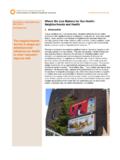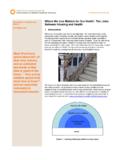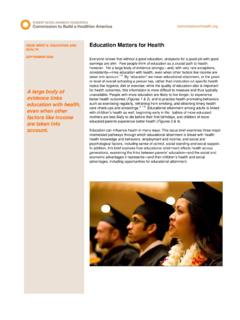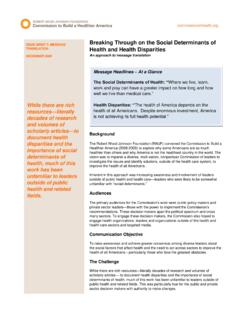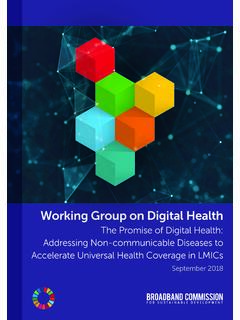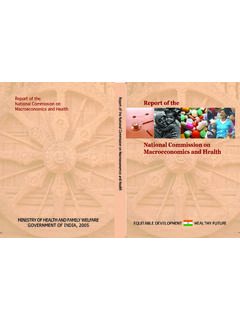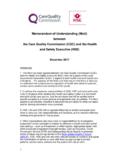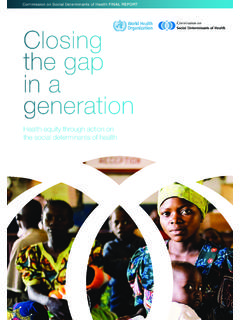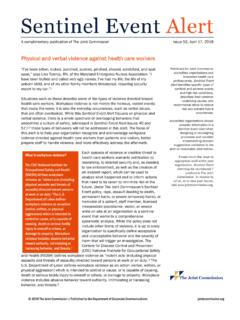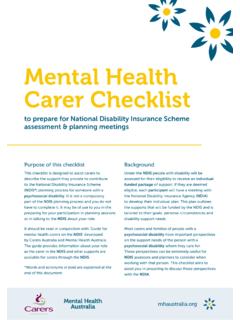Transcription of ISSUE BRIEF 4: WORK AND HEALTH Work Matters for …
1 work Matters for HEALTH ISSUE BRIEF 4: work AND HEALTH DECEMBER 2008 1. Introduction Our work affects our HEALTH in many ways and our HEALTH affects our work . On average, American adults spend nearly half of their waking hours at Where we work influences our HEALTH , not only by exposing us to physical conditions that have HEALTH effects, but also by providing a setting where healthy activities and behaviors can be promoted. In addition to features of worksites, the nature of the work we do and how it is organized also can affect our physical and mental HEALTH . work can provide a sense of identity, social status and purpose in life, as well as social support. For most Americans, employment is the primary source of income, giving them the means to live in homes and neighborhoods that promote HEALTH and to pursue HEALTH -promoting behaviors. In addition, most Americans obtain their HEALTH care insurance through their jobs. Not only does work affect HEALTH ; HEALTH also affects work .
2 Good HEALTH is often needed for employment, particularly for low-skilled workers. Lack of employment among those who are unable to work because of ill HEALTH can lead to further economic and social disadvantage and fewer resources and opportunities to improve HEALTH , perpetuating a vicious cycle. Healthy workers and their families are likely to incur lower medical costs and be more productive, while those with chronic HEALTH conditions generate higher costs in terms of HEALTH care use, absenteeism, disability and overall reduced Employment-related HEALTH problems have significant human and economic costs for individuals and for society overall. In 2007, over 5,000 fatal and 4 million nonfatal work -related injuries and illnesses were reported in private industry workplaces; about half of the non-fatal injuries resulted in time away from work due to recuperation, job transfer or job Some reports have found that the total economic costs to the nation of occupational illness and injury match those of cancer and nearly those of heart Healthy workers and their families are likely to incur lower medical costs and be more productive, while those with chronic HEALTH conditions generate higher costs in terms of HEALTH care use, absenteeism, disability and overall reduced Workplace injuries and work -related illnesses have a major financial impact on both large and small employers.
3 In 2006, the cost to employers for workers compensation totaled $ This ISSUE BRIEF examines how work can affect HEALTH , exploring the HEALTH effects of both physical and psychosocial aspects of work as well as of work -related opportunities and resources. Examples of promising approaches to making work healthier also are provided. 2. How does work affect HEALTH ? Changes in work and in the workforce: Implications for HEALTH . Both the profile of workers and the nature and structure of work in the United States have evolved over time. Today s workforce is older, more racially and ethnically diverse, and increasingly made up of Along with this growing demographic diversity, the 21st century workplace features more multidisciplinary jobs, more collaborative work and reliance on technology, and a shift away from manufacturing As companies have restructured, both knowledge work requiring a relatively high level of education or technical training and service jobs have become more , 8 The Bureau of Labor Statistics projects that the United States workforce will increase by 22 million workers by 2010, with the largest number of workers employed in professional and related occupations and in the service Today s workers face greater job uncertainty.
4 They are more likely to have many employers and to be required to enhance or expand their skills over the course of their working These shifts in work may have outpaced knowledge about their implications for the quality of working life and for safety and HEALTH on the Measures to protect workers from physically hazardous conditions remain important, but the current context calls for new integrated strategies that not only will protect workers from major hazards but will promote healthier work and workplaces. Measures to protect workers from physically hazardous conditions remain important, but the current context calls for new integrated strategies that not only will protect workers from major hazards but will promote healthier work and workplaces. Page 2 The links between HEALTH and the physical aspects of work . There is widespread awareness that both the physical tasks involved in a job and the physical work environment can have important HEALTH effects. These concerns have been the traditional domain of occupational HEALTH and safety.
5 Physical working conditions and risk of injury and illness. The type of work and the tasks involved influence a worker s risk of physical injury and illness. Workers in particular sectors of the work force are at increased risk of work -related injuries and illness. Eight sectors air transportation, nursing facilities, work with motorized vehicles and equipment, trucking services, hospitals, grocery and department stores, and food services account for nearly 30 percent of nonfatal occupational Certain jobs are also associated with higher risks. For example, operators, fabricators and laborers suffered nearly 40 percent of all reported occupational illnesses and injuries in 2001, while representing only 15 percent of Certain jobs are associated with higher HEALTH risks. For example, operators, fabricators and laborers suffered nearly 40 percent of all reported occupational illnesses and injuries in 2001, while representing only 15 percent of Physically demanding daily tasks and uncomfortable working positions can lead to physical strain and injury, increasing the risk of long-term Jobs requiring repetitive movements and those with high physical workload including lifting, pushing or pulling heavy loads put workers at higher risk for musculoskeletal injuries and disorders, overextension and repetitive strain Carpal tunnel syndrome, caused by repetitive motion, accounted for the highest median days (25 days) away from work among all occupational illness or injuries in The ergonomics of equipment and work space are important contributors to occupational HEALTH .
6 For example, poorly designed tools, keyboards and chairs have been linked with arm, back and shoulder pain, as well as other musculoskeletal Sedentary jobs allow few opportunities for movement or exercise, and physical inactivity contributes to risk of obesity and chronic diseases such as diabetes and heart Hazardous exposures in the workplace. In addition to workplace conditions like inadequate ventilation or temperature control that can aggravate allergies or asthma,14 the physical environment of a workplace can expose workers to a variety of potentially hazardous chemicals. Lead, pesticides, aerosols, ammonia and other cleaning products, and asbestos are just a few of the many workplace-related chemicals for which long-term exposure have been related to poisoning and serious ,15 Hearing loss from noisy work environments is one of the most common occupational injuries worldwide, and workplace noise also creates a higher risk of ,17 The psychosocial aspects of work and how work is organized also can affect HEALTH .
7 The experience of work itself how time is organized, and the social and psychological aspects of working conditions affect both physical and mental HEALTH . Differences in the degree of control that workers feel they have over their working conditions are thought to be a major factor accounting for steep social gradients in HEALTH among employed civil servants in the United ,19 For many Americans, work is a major source of opportunities for personal development and building stable social networks. These opportunities are shaped by many characteristics of the work environment, including workplace culture, job demands and latitude in making decisions about one s work . Page 3 work schedules. Evening and night shifts, holding multiple jobs, long work hours and excessive overtime work can be detrimental to HEALTH by causing fatigue and disturbances in circadian rhythms. Sleep deprivation leads to decreased concentration and lower cognitive performance, and can cause mistakes that negatively impact an employee s HEALTH , work , or , 21 Working more than 40 hours per week has been associated with poorer perceived overall HEALTH , increased injury and illness rates and increased mortality, with especially pronounced effects in conjunction with extended work shifts that are longer than 8 Reducing work -related stress can have positive HEALTH impacts not only for workers but for their children as well.
8 Commuting to work . More Americans commute to and from work than in the past, and they are travelling longer distances; million Americans have work commutes of 50 miles or more each Longer commutes by both train and automobile have been associated with greater levels of ,25 Car commuting also has been linked with physical ailments such as lower back pain,25 increased likelihood of obesity, 26 and less time for leisure and social Of the 134 million people in the United States who worked outside their homes during 2007, 120 million commuted in cars, contributing to traffic congestion, air pollution, reduced physical activity and risk of injury and death due to As an alternative to car commuting, public transit has been linked with greater physical Balancing work and family responsibilities: HEALTH implications. Since 1970, average hours worked by both parents in two-parent families with children under 18 years of age have increased by approximately 11 hours per week; over the same time period, more single mothers have joined the work force and are working longer For many families, these changes represent substantial declines in time for activities like housework, childcare, leisure and sleep adding additional strain on families, especially in times of injury or Parents reporting stress due to the spillover of work to family life are more likely to suffer from mood, anxiety and substance dependence Reducing work -related stress can have positive HEALTH impacts not only for workers but for their children as well.
9 By allowing workers to have more control over their schedules, workplace policies such as flextime (which permits employees to schedule workday start and end times to accommodate family responsibilities) and supportive breastfeeding policies can improve HEALTH and well-being for workers and their families. Control at work , demands and decision latitude. Jobs characterized by both high psychological demands and high levels of decision-making authority and skill utilization ( decision latitude ) can promote self esteem and self efficacy. Conversely, workers whose jobs make high demands yet offer little decision latitude experience what has been called job strain. They are more likely to suffer from psychological distress, and are at higher risk of chronic physical illnesses (such as cardiovascular disease) and unhealthy coping behaviors (such as smoking) that contribute to these ,32 Control at work is considered by some experts to account for a large part of socioeconomic differences in HEALTH among employed ,19 The balance between efforts and rewards.
10 Perceived balance between a worker s efforts and rewards (in terms of earnings, benefits, esteem, jobsecurity and career opportunities) also has been shown to influence HEALTH . Imbalance of high efforts with low rewards has been associated with poor physical functioning33 and increased incidence of coronary heart disease,34 as well as with moderately elevated risks of impaired mental and social functioning and onset of mild psychiatric ,35 Page 4 Organizational justice. Organizational justice characterizes both processes and relationships in the workplace. The former include whether decisions are made with input from affected parties, are consistently applied, and suppress bias; the latter include whether supervisors treat employees with respect, transparency and fairness. In the context of work , each of these components can affect both physical and mental HEALTH and well-being. Workers who experience low levels of relational justice have longer periods of illness-related absence compared with those who experience high levels of Lower levels of justice have been associated with poorer HEALTH , higher self-reported morbidity, and increased mental HEALTH problems;37 a combination of high effort-reward imbalance and high organizational injustice was associated with a greater HEALTH risk than either work environments that facilitate mutual support between coworkers can reduce job stress and may provide a buffer against physical and mental HEALTH stressors related to Social support at work .
